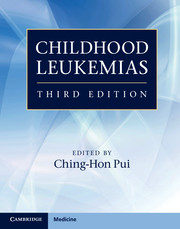Book contents
- Frontmatter
- Contents
- List of contributors
- Preface
- Section 1 History and general issues
- Section 2 Cell biology and pathobiology
- Section 3 Evaluation and treatment
- 12 Pharmacokinetic, pharmacodynamic, and pharmacogenetic considerations
- 13 Acute lymphoblastic leukemia
- 14 Relapsed acute lymphoblastic leukemia
- 15 B-cell acute lymphoblastic leukemia and Burkitt lymphoma
- 16 Acute myeloid leukemia
- 17 Relapsed acute myeloid leukemia
- 18 Myelodysplastic syndrome
- 19 Chronic myeloproliferative disorders
- 20 Leukemias in patients with Down syndrome
- 21 Treatment of adolescents and young adults with acute lymphoblastic leukemia
- 22 Hematopoietic stem cell and natural killer cell transplantation
- 23 Treatment of acute leukemia in countries with limited resources
- 24 Antibody-targeted therapy
- 25 Adoptive cellular immunotherapy
- 26 Gene transfer: methods and applications
- 27 Development therapeutics
- 28 Minimal residual disease
- Section 4 Complications and supportive care
- Index
- Plate Section
- References
22 - Hematopoietic stem cell and natural killer cell transplantation
from Section 3 - Evaluation and treatment
Published online by Cambridge University Press: 05 April 2013
- Frontmatter
- Contents
- List of contributors
- Preface
- Section 1 History and general issues
- Section 2 Cell biology and pathobiology
- Section 3 Evaluation and treatment
- 12 Pharmacokinetic, pharmacodynamic, and pharmacogenetic considerations
- 13 Acute lymphoblastic leukemia
- 14 Relapsed acute lymphoblastic leukemia
- 15 B-cell acute lymphoblastic leukemia and Burkitt lymphoma
- 16 Acute myeloid leukemia
- 17 Relapsed acute myeloid leukemia
- 18 Myelodysplastic syndrome
- 19 Chronic myeloproliferative disorders
- 20 Leukemias in patients with Down syndrome
- 21 Treatment of adolescents and young adults with acute lymphoblastic leukemia
- 22 Hematopoietic stem cell and natural killer cell transplantation
- 23 Treatment of acute leukemia in countries with limited resources
- 24 Antibody-targeted therapy
- 25 Adoptive cellular immunotherapy
- 26 Gene transfer: methods and applications
- 27 Development therapeutics
- 28 Minimal residual disease
- Section 4 Complications and supportive care
- Index
- Plate Section
- References
Summary
Introduction
Blood and bone marrow (BM) transplantation (BMT) or hematopoietic stem cell transplantation (HSCT) are procedures that utilize autologous or allogeneic cells to reconstitute a hematopoietic system, after chemotherapy with or without total body irradiation (TBI) to treat cancer intensively or suppress the recipient immunologically to prevent rejection. When used to treat leukemia, the intent of most transplantation approaches in pediatrics is to decrease relapse by using very high doses of cancer therapy to overcome partially resistant cancer cells. Standard high-dose “preparative” regimens (myeloablative regimens) cause irreversible BM failure unless there is “rescue” by the stem cell infusion. While the intensity of therapy alone is sufficient to cure some resistant malignancies, allogeneic transplantation has been noted to add an immunotherapeutic benefit, termed the graft-versus-leukemia (GVL) effect. Sources of hematopoietic stem cells currently used for HSCT include BM, peripheral blood stem cells (PBSC), and umbilical cord blood (CB).
Because intensive therapy associated with the transplantation process can result in organ damage, susceptibility to life-threatening infection, late effects such as growth delay, and immunologic complications such as graft-versus-host disease (GVHD), it is reserved for cancers not curable with standard chemotherapeutic approaches or where there is a significant survival advantage over less intense therapies. Traditional indications for HSCT in leukemia include first or subsequent relapse and the very highest risk subclassifications of leukemias in first remission. As chemotherapy and transplantation outcomes improve, and as more precise definitions of disease risk are discovered, indications for transplantation change. Therefore, careful dialogue between oncologists and transplant physicians should occur early in the course of therapy for high-risk leukemias to determine when or if a transplantation procedure is indicated.
- Type
- Chapter
- Information
- Childhood Leukemias , pp. 527 - 548Publisher: Cambridge University PressPrint publication year: 2012



